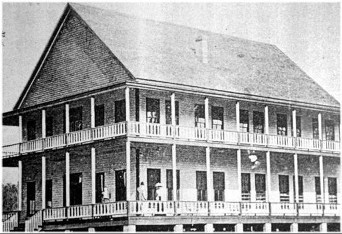Civil War Confederate Hospitals In Alabama
“Confederate military medical authorities established general hospitals behind the lines in at least thirty-nine cities and towns in Georgia, though many of them remained at a particular location for only a short time.
There were two types of hospitals during the Civil War. Field hospitals accompanied the armies, treating the sick and wounded first before sending those needing lengthier care to the general hospitals behind the lines, often at some distance from the front. Each general hospital had a staff, preferably of a size appropriate to its bed capacity. This staff included surgeons and assistant surgeons, a steward (manager and pharmacist), ward masters (supervisors), nurses, female matrons (domestic supervisors), cooks, and laundresses.”
HDQRS. DEPARTMENT OF ALA., MISS., AND EAST LA.,
Meridian, December 20, 1864.
Lieutenant-General TAYLOR,
Commanding Department:
GENERAL: I have the honor to report that, in obedience to orders, I visited the District of the Gulf for the purpose of inspecting the hospitals therein. After visiting the Nott hospital, which I found cleanly, well administered, and well appointed in all respects, I learned that Surgeon Brodie, medical director of the Western Division, had just completed an inspection, which i concluded would obviate the necessity of any official action on my part for the present. I have the honor to furnish you the accompanying list of hospitals in the district, their capacity, names of officers in charge, and number of patients now under treatment. I have the honor also to state that Surgeon Heustis, medical director of hospitals of this department, informed [me] that the capacity of the hospital in Mobile could be largely increased, sufficiently so to meet any emergency that may occur.
I have the honor to remain, most respectfully, &c.,
P. B. McKELVEY,
Surgeon and Assistant Inspector of Hospitals,
Department of Alabama, Mississippi, and East Louisiana.
List of hospitals in the Gulf District.
Hospitals. Capaci Station. Surgeon in charge.
ty.
Beds.
Ross. 250 Mobile, Ala. S. L. Nidelet.
Cantey. 150 ..do…….. William Henderson.
Moore. 123 ..do…….. W. C. Cavenagh.
Le Vert. 30 ..do…….. R. H. Redwood.
Nott. 51 ..do…….. G. A. Nott.
Nidelet. 120 ..do…….. S. L. Paine.
Heustis. 90 ..do…….. J. M. Heard.
Miller. 170 Greenville, G. Owen.
Ala.
General 150 ..do…….. R. B. Maury.
hospital.
Total sick in hospital, 712.

Confederate Civil War Field Hospital
| STATE | CITY | HOSPITAL | MEDICAL OFFICER (SURGEON) |
| Alabama | Mobile | Nott | G.A. Nott |
Nott HospitalOn May 14, 1863, a hotel on Royal Street became the S.P. Moore Hospital. The Soldiers Rest Hospital opened on July 18, 1865, and one year later it was converted into a hospital for officers only. Several days after the opening of this latter facility, the Nott Hospital began receiving patients. Mobile’s medical staff converted the Kennedy House Hotel into the Heustis Hospital on October 18, 1864. On November 23, 1864, the Mansion House Hotel became Nidelet Hospital, the last medical facility established by the military in Mobile. Both of the former hotels required extensive cleaning and renovation but became excellent hospitals. Credit: Mobile Daily Advertiser, Jan. 9, 22, 1861 |
|||
| Alabama | Mobile | General | W.C. Cavanaugh
surg., with J.K. Walker’s Tenn. Regt., 1861; surg., M.I.; acting M.D. to Maj. Gen. L. Polk August 27, 1862; M.D. Army of the Mississippi, October 26, 1862; M.D. to Lieut. Gen. L. Polk, January 1, 1863; in charge Hospital “Moore,” Dist. of the Gulf, October 23, 1864 |
| Alabama | Mobile | General/Ross | S.L. Nidelet |
| Alabama | Mobile | General | W. Henderson |
| Alabama | Mobile | General | R.H. Redwood
02/19/1864 – Assigned by Maj. Gen. D. H. Maury to the position of Surgeon-in-charge, LeVert Hospital, Mobile, AL |
| Alabama | Greenville | General | R.B. Maury (Assistant) Dr Richard Brooke Maury |
| Alabama | Demopolis | Way | H. Hinckley |
| Alabama | Tuscaloosa | General | R.N. Anderson |
| Alabama | Selma | General | A.Hart |
| Alabama | Selma | Way | W. Curry |
| Alabama | Talladega | Way | G.S. Bryant |
| Alabama | Spring Hill | General | G. Owen |
| Alabama | Eufaula | Way | P.D.L. Baker |
| Alabama | Auburn | Texas | L.A. Byron (Assistant) |
| Alabama | Notasulga | General | U.R. Jones |
| Alabama | Montgomery | Ladies | T.F. Duncan |
| Alabama | Montgomery | Stonewall | W.M. Cole |
| Alabama | Montgomery | Madison House | C.J. Clark |
| Alabama | Montgomery | Concert Hall | W.J. Holt |
| Alabama | Montgomery | St. Mary’s | J.H. Watters |
| Alabama | Montgomery | Watts | F.M. Hereford |
| Alabama | Uniontown | Officer’s | G.C. Gray |
| Alabama | Shelby Springs | General | B.H. Thomas |
Shelby Springs General Hospital Shelby Springs Hotel Site of “General Hospital, Shelby Springs” during the Civil War Photo made before it was destroyed by fire on May 15, 1906 In about 1856 Mr. Jasper J. Norris of Selma leased the property consisting of 2,700 acres of wooded land, including the springs, hotel and cottages. During the Civil War, the facilities were used as a training center for the young Confederate soldiers. In 1862 Shelby Springs was known as Camp Winn. Several students in the University of Alabama Cadet Corps were sent there to drill troops for the Army. In 1863, the Confederate Army as a hospital and a soldier’s home used the hotel and cottages. Father Leray and the Sisters of Mercy staffed the hospital after fleeing Civil War destruction in Vicksburg, Mississippi. They brought with them by train many wounded and sick Confederate soldiers. |
|||